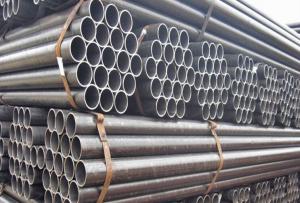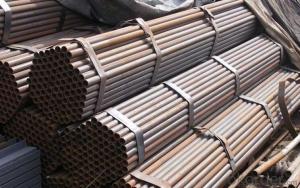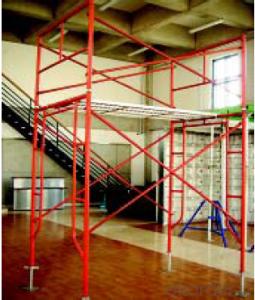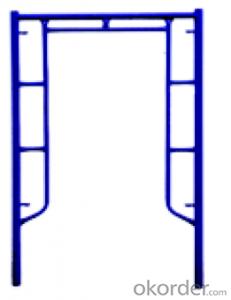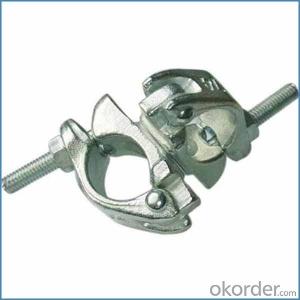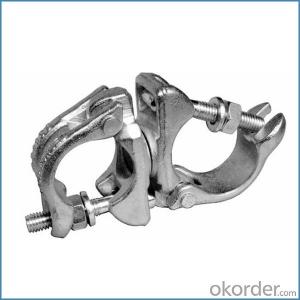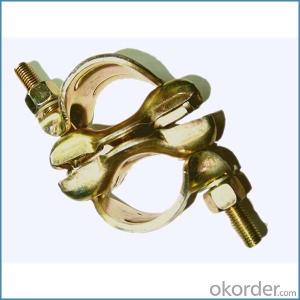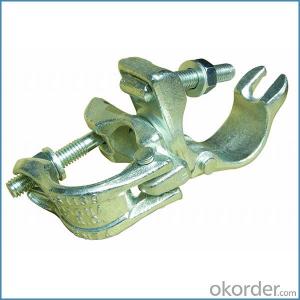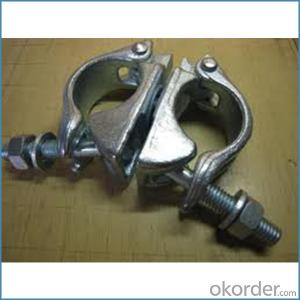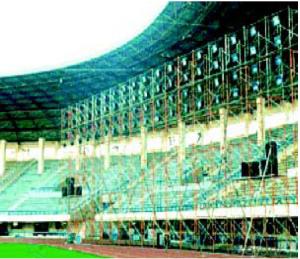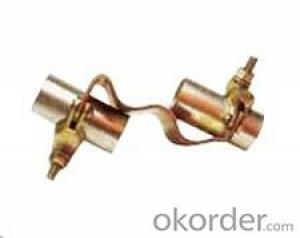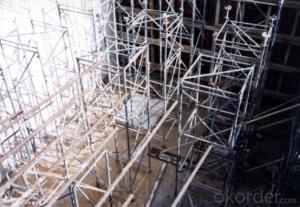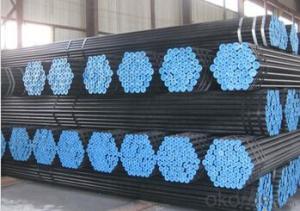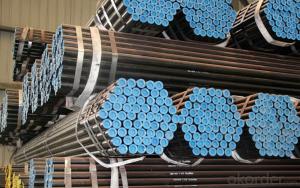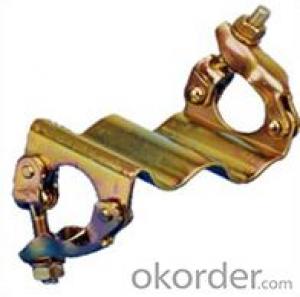Post Coupler British Type for Sale in China
- Loading Port:
- Tianjin
- Payment Terms:
- TT OR LC
- Min Order Qty:
- 1000 kg
- Supply Capability:
- 100000 kg/month
OKorder Service Pledge
OKorder Financial Service
You Might Also Like
Post Coupler British Type for Sale
Description
1.The scaffolding coupler is always used to connect the steel pipe as scaffolding system.
2.The often used coupler is swivel coupler and righ angle coupler .
3.We can provide types of scaffolding coupler according to your requirement.
4.Couoler can fix the 48.3mm scaffolding steel pipe tightly and make the whole scaffolding system more steadily.
5.Material:Q235 steel
6.Overall Size:48.3mm*48.3mm
7.Surface Finish: Galvanized/ Painted
8.Standard:BS1139,EN74
9.Package:25pcs/bag
10.Manufactuering as per customer requirements
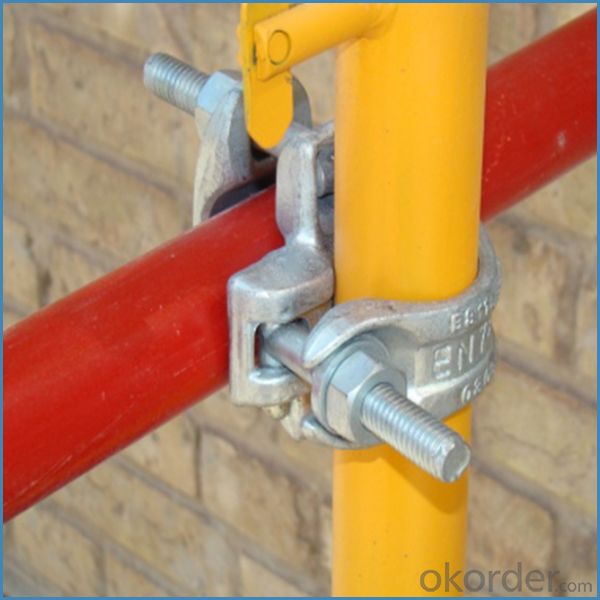
Feature
(1)Excellent Anti-Breaking—Cold Pressed Steel
(2)Outstanding Resistance Deformation
(3)Strong Anti-Dropping Ability
(4)Longtime USe
(5)Qualtity Guaranteed
(6)OEM Service
Photo

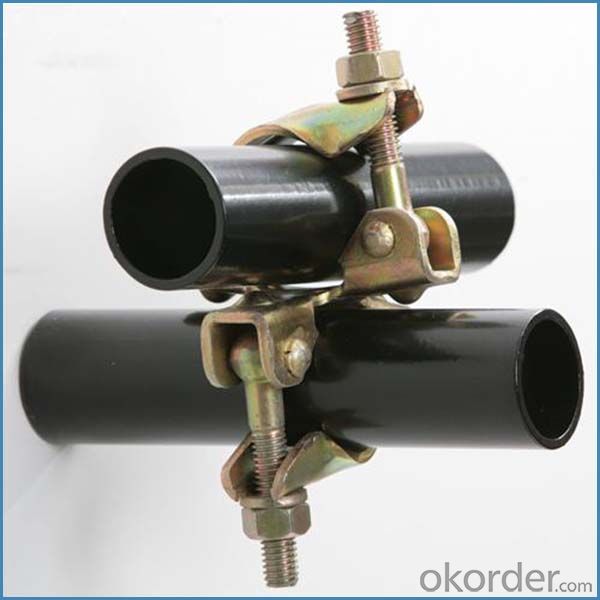
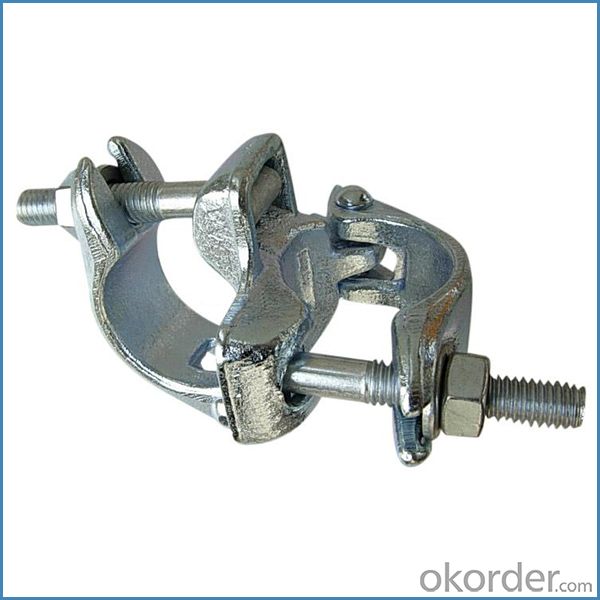
Parameter
| Material | Q235,345steel |
| Size | 48.3mm*48.3mm |
| Surface finish | Galvanized |
| Weight | 1.1kg around |
| Standard | BS1139,EN74 |
| Package | 25pcs/bag,steel pallet |
| Manufacture | As per customer requirement |
| Market | Africa, South America, the Middle East and Asia |
FAQ
Q: Are you a factory or trading company?
We are a state-owned corporation in China,dealing with various kinds of building materials.We have our holding subsidiaries.
Q: Where is your factory located? How can I visit there?
Our factory is located all around China.
Q: Can I get some samples?
Sample is free, customer only pay freight for the first time.
Q: Delivery?
10-30days. (5-15 containers)
Any question,feel free to contact us.
- Q: Can steel tube couplers be used in extreme weather conditions?
- Yes, steel tube couplers can be used in extreme weather conditions. Steel is a highly durable and weather-resistant material, making it suitable for various applications in harsh environments. Steel tube couplers are designed to provide strong and reliable connections between steel tubes, ensuring the structural integrity of the system. Whether it is extreme heat, cold, humidity, or exposure to UV radiation, steel tube couplers are built to withstand these conditions. Additionally, steel's high tensile strength and corrosion resistance make it a preferred choice for applications in extreme weather conditions. However, it is important to note that proper installation and maintenance are crucial to ensure the longevity and performance of steel tube couplers in any weather condition.
- Q: How do steel tube couplers affect the stability and rigidity of a scaffolding structure?
- The stability and rigidity of a scaffolding structure heavily rely on steel tube couplers. These crucial components are designed to connect and secure the steel tubes used in constructing the scaffolding system. By creating a strong and dependable connection between the tubes, they improve the overall stability and rigidity of the structure. One way in which steel tube couplers impact stability is by preventing any movement or displacement of the individual tubes. They firmly hold the tubes together, ensuring that they do not slide or shift out of position. This guarantees that the scaffolding remains stable, even when faced with external forces like wind or vibrations from workers or equipment. Furthermore, steel tube couplers contribute to the rigidity of the scaffolding structure by eliminating any gaps or play between the tubes. This tight connection enhances the scaffold's load-bearing capacity and minimizes any deflection or bending of the structure. As a result, the scaffolding can support heavy loads and provide a secure working platform for workers. Moreover, the use of steel tube couplers allows for the construction of various types of scaffolding configurations. Couplers enable the connection of tubes at different angles, accommodating the specific requirements of the job site. This flexibility enhances the stability of the structure, especially on uneven terrain or in the presence of complex architectural features. To summarize, steel tube couplers are indispensable components of a scaffolding structure. Their role in enhancing stability and rigidity is crucial. By securely connecting and preventing any movement between the steel tubes, these couplers ensure the stability of the scaffolding and its ability to bear heavy loads. Additionally, they provide flexibility in construction configurations, allowing for adaptability to different job site conditions. Ultimately, the use of steel tube couplers is vital for creating a safe and robust scaffolding system.
- Q: What are the potential risks or hazards associated with steel tube couplers in scaffolding?
- There are several potential risks or hazards associated with steel tube couplers in scaffolding. Firstly, one of the main risks is structural failure. If the steel tube couplers are not properly installed or tightened, they may not be able to support the weight of the scaffolding and workers, leading to collapse or instability. This can result in serious injuries or even fatalities. Secondly, if the steel tube couplers are of low quality or not manufactured to the required standards, they may have weak points or defects that can compromise their strength and integrity. This increases the risk of failure and can lead to accidents on the scaffolding. Another potential hazard is improper use or overloading of the steel tube couplers. If workers exceed the weight or load capacity of the couplers, they can become stressed or damaged, increasing the likelihood of failure. It is important for workers to be trained on the proper use and limitations of the couplers to prevent accidents. Additionally, poor maintenance or lack of regular inspections can also pose risks. Over time, steel tube couplers can become corroded or damaged due to exposure to weather conditions or misuse. If not properly maintained or inspected, these couplers can deteriorate and become unsafe, posing a hazard to workers on the scaffolding. Lastly, the use of damaged or incompatible couplers can also be a risk. Couplers that are bent, cracked, or have other visible signs of damage should not be used as they may not provide the required strength and stability. Similarly, using couplers from different manufacturers or with different dimensions can compromise the structural integrity of the scaffolding. To mitigate these risks, it is important to ensure that steel tube couplers used in scaffolding are of high quality, meet the required standards, and are properly installed and maintained. Regular inspections should be conducted to identify any signs of damage or deterioration, and workers should be trained on the proper use and limitations of the couplers. Additionally, load capacities should be strictly adhered to and workers should be aware of the importance of not overloading the scaffolding.
- Q: Can steel tube couplers be used for scaffolding structures that need to provide access to overhead or elevated areas?
- Yes, steel tube couplers can be used for scaffolding structures that need to provide access to overhead or elevated areas. Steel tube couplers are commonly used in scaffolding systems to connect and secure steel tubes together, creating a stable and secure structure. These couplers are designed to withstand heavy loads and provide a reliable connection between the tubes, ensuring the safety of workers accessing overhead or elevated areas. By using steel tube couplers, scaffolding structures can be easily assembled and disassembled, providing flexibility in constructing scaffolds for various applications. Furthermore, steel tube couplers are highly durable and resistant to corrosion, making them suitable for long-term use in outdoor environments. Overall, steel tube couplers are an essential component in scaffolding systems, enabling safe and efficient access to overhead or elevated areas.
- Q: What are the common methods of securing steel tube couplers to scaffolding tubes to prevent accidental disconnection or detachment?
- There are several common methods used to secure steel tube couplers to scaffolding tubes in order to prevent accidental disconnection or detachment. 1. Gravitational force: This method relies on the weight of the scaffolding components to keep them connected. By ensuring that the tube couplers are properly aligned and tightened, the weight of the structure helps to maintain their connection. 2. Wedge method: The wedge method involves using a wedge-shaped piece of metal or plastic to secure the tube couplers tightly against the scaffolding tubes. The wedge is inserted into the gap between the tube coupler and the tube, creating a secure fit. 3. Set screws: Set screws are threaded screws that are tightened onto the scaffolding tube, effectively clamping the tube coupler in place. These screws are often positioned at an angle to ensure a stronger grip and prevent accidental disconnection. 4. Safety pins or spring clips: Safety pins or spring clips are commonly used to secure tube couplers to scaffolding tubes. These devices are inserted through pre-drilled holes in the coupler and tube, creating a physical barrier that prevents accidental detachment. 5. Twist lock mechanism: Some tube couplers incorporate a twist lock mechanism, which requires a twisting motion to secure the coupler onto the tube. This mechanism provides a secure and reliable connection that is resistant to accidental disconnection. It is important to note that regardless of the method used, regular inspections and maintenance should be conducted to ensure the integrity of the scaffolding structure. Additionally, following proper guidelines and standards for scaffolding assembly and usage is crucial to ensure the safety of workers and prevent accidents.
- Q: Are steel tube couplers resistant to compression or crushing forces in scaffolding structures?
- Steel tube couplers are capable of resisting compression or crushing forces in scaffolding structures. Steel, being a robust and durable material, can endure significant pressure and weight. Couplers are specifically designed to securely connect steel tubes, ensuring stability and support for the scaffolding structure. Manufacturers adhere to industry standards while producing these couplers and conduct tests to ascertain their capacity to withstand compression forces. Consequently, steel tube couplers are dependable and can endure the compression or crushing forces that may be applied to scaffolding structures.
- Q: How do steel tube couplers contribute to the overall stability and strength of scaffolding?
- The stability and strength of scaffolding structures are greatly enhanced by steel tube couplers. These crucial components securely connect and join steel tubes, creating a rigid and stable framework. To begin with, steel tube couplers ensure a reliable and strong connection between tubes, maintaining the stability of the scaffold and supporting heavy loads. By gripping the tubes tightly, they prevent any movement or slippage, even under significant pressure. This secure connection is vital for both the integrity of the scaffold and the safety of workers who depend on it. Furthermore, the weight and load are evenly distributed across the scaffold structure thanks to steel tube couplers. By connecting the tubes at various points, the couplers effectively transfer the load from one tube to another, evenly distributing the weight throughout the scaffold. This distribution of weight prevents any single tube from experiencing excessive stress, minimizing the risk of failure or collapse. In addition, steel tube couplers provide the convenience of easy assembly and disassembly of the scaffold. They allow for quick and simple connections between tubes, facilitating efficient construction and dismantling processes. This ease of assembly not only saves time and labor but also contributes to the stability of the scaffold by ensuring secure connections between all components. Moreover, steel tube couplers are highly durable and corrosion-resistant, making them suitable for long-term use in various weather conditions. Their robust construction ensures they can withstand the challenges of construction sites, providing a reliable connection between tubes for extended periods. In conclusion, steel tube couplers play a significant role in enhancing the overall stability and strength of scaffolding structures. They provide a secure connection between tubes, distribute the weight evenly, facilitate easy assembly, and offer durability and resistance to corrosion. These factors combine to improve the safety and reliability of scaffolding, making steel tube couplers an essential component in construction projects.
- Q: Can steel tube couplers be used for scaffolding systems that require high resistance to impact?
- Yes, steel tube couplers can be used for scaffolding systems that require high resistance to impact. Steel tube couplers are designed to securely connect steel tubes in scaffolding structures, providing stability and strength. Steel is known for its durability and high strength-to-weight ratio, making it an ideal material for scaffolding systems that require high resistance to impact. Additionally, steel tube couplers undergo rigorous testing and must meet specific standards to ensure their reliability and performance. Therefore, using steel tube couplers in scaffolding systems that require high resistance to impact is a suitable and safe choice.
- Q: How do steel tube couplers perform in areas with high levels of dust or debris?
- Steel tube couplers have been designed to establish a reliable connection between two steel tubes, guaranteeing both structural integrity and load transfer. In environments where dust or debris levels are elevated, the efficiency of steel tube couplers may be moderately affected. The existence of dust or debris has the potential to impede the appropriate engagement of the couplers, resulting in difficulties achieving a tight fit. This, in turn, can compromise the overall strength and stability of the connection, potentially resulting in a weakened structure. Moreover, the accumulation of dust or debris can cause abrasion and wear on the surfaces of the couplers, reducing their lifespan and potentially impacting their performance over time. However, it is important to note that the impact of dust or debris on steel tube couplers can be minimized by implementing suitable measures. The regular cleaning and maintenance of the couplers can help prevent the build-up of dust and debris, ensuring a smooth and secure connection. Additionally, the utilization of protective covers or sealing mechanisms can help safeguard the couplers from external contaminants, thereby prolonging their durability and performance in dusty or debris-filled environments. In conclusion, while steel tube couplers may encounter some challenges in areas with high levels of dust or debris, proper cleaning, maintenance, and the implementation of protective measures can aid in mitigating these issues and guaranteeing their optimal performance.
- Q: Can steel tube couplers be used in scaffolding projects with uneven ground conditions?
- Yes, steel tube couplers can be used in scaffolding projects with uneven ground conditions. Steel tube couplers are designed to connect steel tubes together, providing a secure and stable structure for scaffolding. They are versatile and can be used in various configurations to adapt to different ground conditions. When working with uneven ground, adjustable base plates or screw jacks can be used in conjunction with the steel tube couplers to level the scaffolding and ensure its stability. Additionally, diagonal braces can be added to enhance the rigidity and strength of the scaffolding, compensating for any unevenness in the ground. Overall, steel tube couplers are a reliable and adaptable solution for scaffolding projects, even in challenging ground conditions.
Send your message to us
Post Coupler British Type for Sale in China
- Loading Port:
- Tianjin
- Payment Terms:
- TT OR LC
- Min Order Qty:
- 1000 kg
- Supply Capability:
- 100000 kg/month
OKorder Service Pledge
OKorder Financial Service
Similar products
Hot products
Hot Searches
Related keywords








